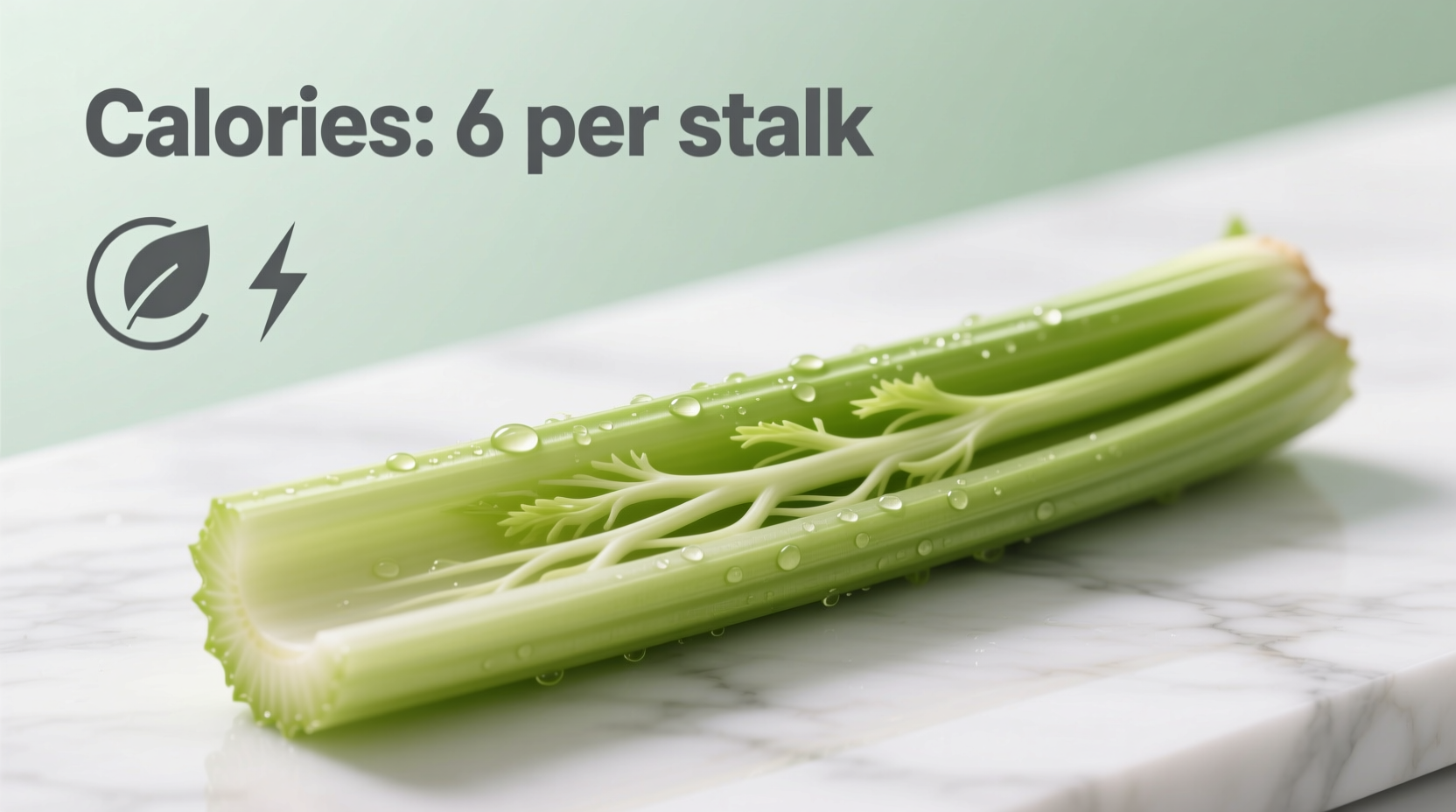Discover exactly how celery fits into your nutrition plan with precise measurements you can trust. Whether you're tracking calories for weight loss, managing dietary restrictions, or simply curious about this crunchy vegetable, you'll get science-backed facts that help you make informed food choices.
Understanding Celery's Calorie Count
When you're monitoring your daily calorie intake, knowing the exact nutritional value of common foods becomes essential. The humble celery stalk often appears in diet plans and weight loss programs, but what's the real story behind its calorie content? Let's examine the facts from authoritative sources.
According to the USDA FoodData Central, the gold standard for nutritional information in the United States, one medium raw celery stalk (about 40g) contains precisely 6 calories. This consistent measurement comes from extensive laboratory analysis of celery samples across multiple growing seasons and regions.

Celery Measurements: Beyond the Single Stalk
Understanding celery's calorie content in various measurements helps when following recipes or meal plans:
| Celery Measurement | Weight | Calories | Carbohydrates |
|---|---|---|---|
| One medium stalk | 40g | 6 | 1.2g |
| One cup chopped | 101g | 16 | 3g |
| One cup sliced | 110g | 17 | 3.3g |
| One cup diced | 120g | 18 | 3.6g |
Why Celery's Calorie Count Matters for Healthy Eating
Celery's extremely low calorie density makes it valuable for several dietary approaches. With approximately 95% water content and minimal natural sugars, celery provides volume and crunch without significant caloric impact. This characteristic explains why nutritionists frequently recommend celery as a snack option for weight management.
The concept of "negative calorie foods" often gets mentioned with celery, suggesting your body burns more calories digesting it than the food provides. While this specific claim lacks strong scientific evidence, research published in the Journal of the Academy of Nutrition and Dietetics confirms that high-fiber, low-calorie vegetables like celery do require more energy to digest than processed foods, contributing to their weight management benefits.
Comparing Celery to Other Common Vegetables
Understanding where celery stands nutritionally compared to similar vegetables helps put its calorie count in perspective:
| Vegetable | Measurement | Calories | Fiber (g) | Water Content |
|---|---|---|---|---|
| Celery | 1 medium stalk (40g) | 6 | 0.6 | 95% |
| Cucumber | 1/2 cup sliced (52g) | 8 | 0.3 | 96% |
| Lettuce (Romaine) | 1 cup shredded (47g) | 8 | 0.7 | 95% |
| Broccoli | 1 stalk (148g) | 45 | 3.8 | 91% |
Practical Applications for Your Diet
Knowing the exact calorie count in celery stalks allows you to incorporate this vegetable strategically into various eating plans. For those following calorie-restricted diets, celery provides satisfying crunch and volume with minimal caloric impact. Try these practical approaches:
- Replace higher-calorie snacks with celery sticks paired with 1 tablespoon of natural peanut butter (total: 106 calories)
- Add chopped celery to tuna or chicken salad to increase volume without significantly increasing calories
- Use celery as a vehicle for small portions of hummus or Greek yogurt dip
- Create a low-calorie base for soups and stews by starting with celery, onions, and carrots
Context Matters: When Celery's Calorie Count Changes
While raw celery maintains a consistent 6 calories per stalk, preparation methods significantly affect its nutritional profile. When celery appears in cooked dishes or paired with other ingredients, the calorie count changes:
- Celery cooked in soups or stews retains its low calorie count but may absorb fats from broth
- Celery in stir-fries gains calories from cooking oils (approximately 45-90 additional calories per teaspoon of oil)
- Celery juice contains similar calories to whole celery but lacks fiber, potentially affecting satiety
- Celery in creamy soups or casseroles absorbs significant additional calories from dairy components
Registered dietitians from the Academy of Nutrition and Dietetics emphasize that while celery itself remains low calorie, how you prepare and serve it determines its overall impact on your daily intake.
Addressing Common Misconceptions
Several myths surround celery's calorie content that deserve clarification:
Myth: Celery has "negative calories" - your body burns more calories digesting it than it provides.
Fact: While celery requires some energy for digestion, research from the National Academies of Sciences, Engineering, and Medicine shows the thermic effect of food for vegetables like celery is approximately 5-10% of their caloric value, not exceeding it.
Myth: All celery varieties have identical calorie counts.
Fact: While differences are minimal, organic celery may contain slightly fewer calories than conventionally grown varieties due to lower sugar content, though the difference (less than 1 calorie per stalk) is nutritionally insignificant.
Scientific Perspective on Celery and Metabolism
Recent studies have examined celery's potential metabolic effects beyond its basic calorie count. Research published in Nutrition Research Reviews indicates that apigenin, a compound found in celery, may influence metabolic processes. However, the concentrations in typical dietary amounts are too low to produce significant metabolic changes.
Nutrition scientists emphasize that celery's primary value comes from its combination of extremely low calories, high water content, and modest fiber contribution - not from any special metabolic properties. This makes it an excellent choice for increasing food volume without substantially increasing calorie intake, supporting sustainable eating habits.
Practical Tips for Tracking Celery in Your Diet
When incorporating celery into your meal planning:
- Use kitchen scales for precise measurements, especially when following strict calorie budgets
- Remember that one medium stalk equals approximately 6 calories, not zero
- Account for any dips, dressings, or cooking oils added to celery
- Consider using celery as a partial replacement for higher-calorie ingredients in recipes
- Track both the celery and any accompaniments in your food logging app
Registered dietitians recommend focusing on celery's role in creating satisfying, voluminous meals rather than fixating on its minimal calorie count. The psychological satisfaction of eating substantial portions contributes significantly to long-term dietary success.
Conclusion: Celery's Role in Balanced Nutrition
With just 6 calories per medium stalk, celery remains one of the most calorie-efficient vegetables you can include in your diet. Its high water content, modest fiber contribution, and versatility make it valuable for various eating approaches. While it won't transform your metabolism or provide miraculous weight loss, celery serves as an excellent tool for increasing food volume without significantly impacting your daily calorie budget. Understanding the precise nutritional facts helps you make informed choices that support your health goals without falling for common dietary myths.











 浙公网安备
33010002000092号
浙公网安备
33010002000092号 浙B2-20120091-4
浙B2-20120091-4